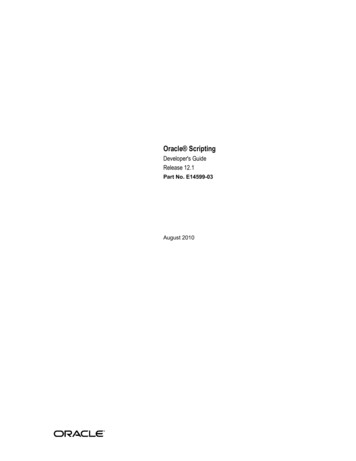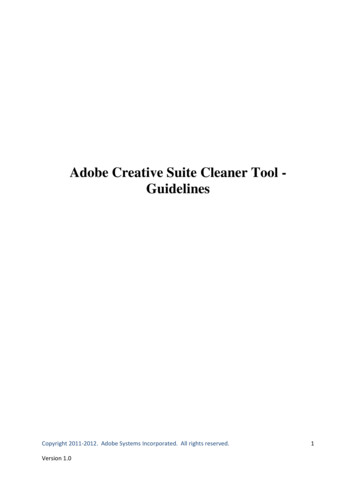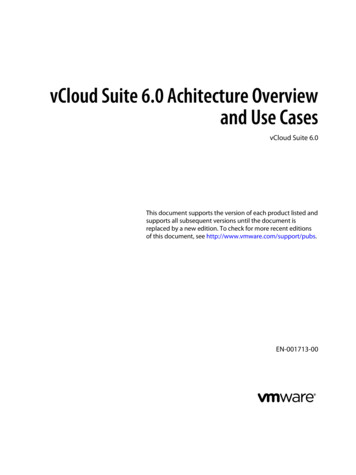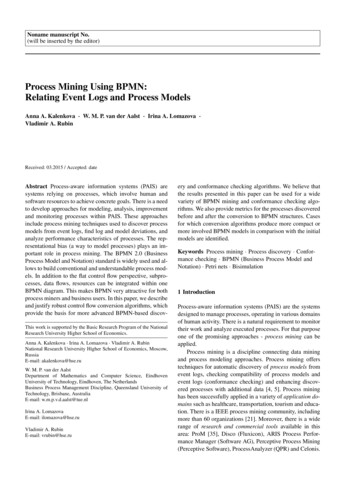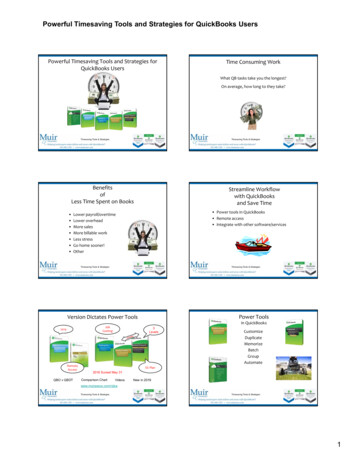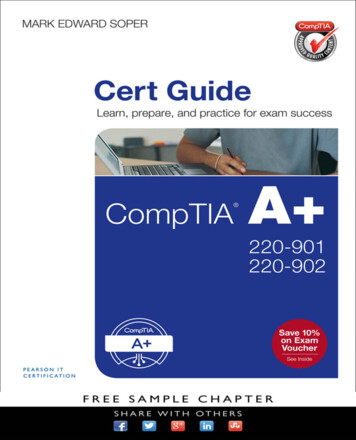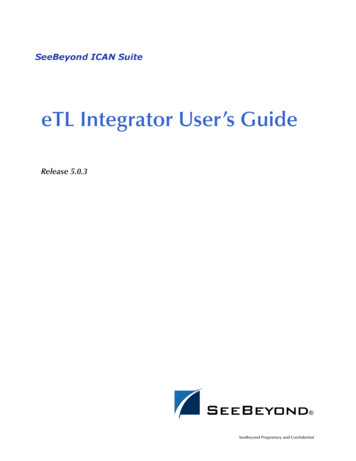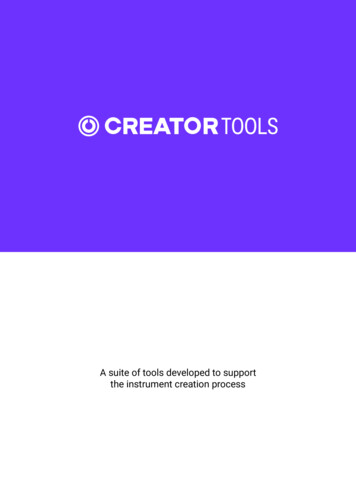
Transcription
1A suite of tools developed to supportthe instrument creation process
Table of Contents1. Creator Tools . 31.1. Project Panel [ /Ctrl-1] . 31.1.1. Project Manager [F1] . 31.1.2. File Browser . 51.2. Top Panel [ /Ctrl-2] . 61.2.1. Instrument Editor [F2] . 61.2.2. GUI Designer [F3] . 71.2.3. Loading in KSP . 91.2.4. Creating and previewing your first Performance View . 101.3. Bottom Panel [ /Ctrl-3] . 101.3.1. KSP Log [ F1] . 101.3.2. KSP Variables [ F2] . 111.3.3. Lua Script [ F3] . 112. Scripting Reference .2.1. Instrument Structure .2.2. Scripting Basics .2.2.1. Script Path .2.2.2. Read properties and print them .2.2.3. Iterate over containers .2.2.4. Changing properties .2.2.5. Working with containers .13131414141415153. Binding Reference .3.1. Type .3.2. Scalars .3.3. Vector .3.4. Struct .3.5. Algorithms .3.6. File system .3.7. PosixTime .3.8. MIR functions .3.8.1. Pitch detection .3.8.2. Peak, RMS & Loudness detection .3.8.3. Type detection .161616171718182121222224
DisclaimerDISCLAIMERThe information in this document is subject to change without notice and does not represent acommitment on the part of Native Instruments GmbH. The software described by this document issubject to a License Agreement and may not be copied to other media. No part of this publicationmay be copied, reproduced or otherwise transmitted or recorded, for any purpose, without priorwritten permission by Native Instruments GmbH, hereinafter referred to as Native Instruments.“Native Instruments”, “NI” and associated logos are (registered) trademarks of Native InstrumentsGmbH.All other trademarks are the property of their respective owners and use of them does not implyany affiliation with or endorsement by them.Document authored by: Elpiniki Pappa, Holger ZwarSoftware version: 1.2.0 (11/2019)Special thanks to the Beta Test Team, who are invaluable not just in tracking down bugs, but inmaking Creator Tools a better product.1
Document ConventionsDOCUMENT CONVENTIONSThis document uses particular formatting to point out special facts and to warn you of potential issues. The icons introducing the following notes let you see what kind of information can be expected:The speech bubble icon indicates a useful tip that may help you to solve a task moreefficiently.The exclamation mark icon highlights important information that is essential for thegiven context.The warning icon warns you of serious issues and potential risks that require yourfull attention.Furthermore, the following formatting is used: Paths to locations on your hard disk or other storage devices are printed in italics. Important names and concepts are printed in bold. Square brackets are used to reference keys on a computer’s keyboard, e.g., Press [Shift] [Enter].2
Creator Tools1. CREATOR TOOLSA suite of tools developed to support the creation of KONTAKT instruments.Creator Tools consists of three panels: the Project Panel (1), the Top Panel (2) and the BottomPanel (3). Each panel contains different tools and can be shown or hidden from the View menu ofthe application top menu or by using dedicated shortcuts. Switching between the tools is possiblefrom the tabs at the top of each panel, from the Go menu of the application top menu or by usingthe dedicated shortcuts. These shortcuts trigger actions related to the active panel in CreatorTools.1.1. Project Panel [ /Ctrl-1]The Project Panel consists of the Project Manager (located at the top of the panel) and the FileBrowser (located at the bottom of the panel). It is a tool for browsing the filesystem and a project'sresources and it allows files to be opened directly from Creator Tools by double-clicking on them.1.1.1. Project Manager [F1]A Creator Tools project file contains all data relevant for the instrument creation process. The format of a Creator Tools project file is JSON, which allows you to use source code version controlsystems.The Project Manager is an editable view of a Creator Tools project file and therefore can only beused when a Creator Tools project file is open. It serves as a central access point for a project'sresources and can, although not necessarily, contain all used resources.The following items are shown in the Project Manager: File and Folder items in a project file reference the corresponding files and folders in the filesystem. If the referenced entity is located in the project file folder or any of its children, the ref3
Creator Toolserence is encoded relative to the project file location. Otherwise, the absolute reference isused. Group items in a project file organize a project as a hierarchical structure. A group can containanother group, a file or a folder.There are no rules enforced about a project file's location or structure. There's not necessarily aproject folder or any form of enforced project folder structure. Multiple project files can exist sideby-side.It is recommended to have a project file residing in a project folder together with subfolders for common resources. When moving a project to other devices or platforms,it is important that the project is self-contained, i.e., contains only relative references.Insert Menu [ /Ctrl- ](1) Files: Opens the OS file selection dialog. For each selected file an entry is inserted.(2) Folder: Opens the OS file selection dialog and inserts the selected folder. Once a folder is selected, its contents are displayed in the File Browser area below.(3) Group: Inserts a new group. Group items can contain files, folders and groups, and can berenamed.(4) Performance View: Opens the OS Save As dialog, which sets the saving location of the newperformance view file. The new performance view item is added to the project.4
Creator ToolsFor all the items described above, if a group is selected and expanded in the Project Manager, theinserted item(s) will be placed into this group. In any other case, the inserted item(s) will be placedabove the currently selected item.ShortcutsUp/down arrows [ / ]Navigate up/downLeft/right arrows [ / ]Expand/collapse groupReturn [ ]Rename group if the current item is a groupOpen the system file-browser if the current item is a folderOpen the file within Creator Tools if the current item is an associated file e.g. performance viewOpen the file with the system associated app e.g. a text editorDouble-clickRename groups if the current item is a groupOpen the file within Creator Tools if the current item is an associated file e.g. performance viewOpen the file with the system associated app e.g. a text editor1.1.2. File BrowserThe File Browser is a secondary area in the Project Panel, located below the Project Manager. It isa read-only view of the filesystem and allows navigation through files and folders. It displays a flatlist of files and/or folders within the current root.(1) Home Button: Navigates to the folder where the project file is located.(2) Parent Button: Navigates to the parent folder of the currently displayed folder.5
Creator ToolsShortcutsUp/down arrows [ / ]Navigate up or downCmd/Ctrl-up [ ]Navigate to parent folderCmd/Ctrl-down [ ]Enter folderReturn [ ]Open the system file-browser if the current item is a folderOpen the file within Creator Tools if the current item is an associated file e.g. performance viewOpen the file with the system associated app e.g. a text editorDouble-clickEnter folderOpen the file within Creator Tools if the current item is an associated file e.g. performance viewOpen the file with the system associated app e.g. a text editor1.2. Top Panel [ /Ctrl-2]The Top Panel consists of the Instrument Editor and the GUI Designer.1.2.1. Instrument Editor [F2]The Instrument Editor connects to a running instance of Kontakt (either plug-in or standalone) anddisplays the structure of an instrument in the form of a nested tree. Combined with the Lua Scripttool in the Bottom Panel, it offers programmatic access to parts of a Kontakt instrument’s structure through Lua-based scripting.(1) Multi Rack Menu: Sets the focus of the tool on the Multi Rack of one of the connected Kontaktinstances.(2) Instrument Menu: Sets the focus of the tool to a specific instrument from the selected MultiRack (1) that is loaded in one of the connected Kontakt instances.Note that instruments with locked edit views cannot be selected.(3) Push: [ /Ctrl-Alt- ] Applies all changes from the Tools' side to Kontakt. If changes are notpushed, an indication on the button appears to notify for the pending changes.6
Creator Tools(4) Pull: [ /Ctrl-Alt- ] Overwrites the current Kontakt state to the tools. Whenever a change takesplace on the Kontakt side, Pull needs to be manually pressed in order to apply the changes in theTools. If changes are not pulled, an indication on the button appears to notify for the pendingchanges.(5) Connection Indicator: Indicates whether a successful connection between the tools and theKontakt instances is established.(6) Instrument Tree View: The instrument structure is displayed in the form of a nested tree. Thetree view shows the basic instrument structure and instrument properties that can be modifiedthrough Lua scripts.1.2.2. GUI Designer [F3]The GUI Designer allows one to assemble, customize and reuse Kontakt performance views andcontrols, without the need to write code. It can generate two types of files, the performance viewfiles (.nckp) and the control files (.nckc).The performance view files (.nckp) contain all the information about an instrument’s graphical interface. These files can then be loaded in a KSP script (see also Loading in KSP). A new performance view file can be created from the Insert menu of the Project Manager.The control files (.nckc) are files that are created by exporting a single control or a container ofcontrols (see also Panels). These files can then be imported in a later GUI Designer project,shared with collaborators or set the foundation for building custom UI libraries. Control files cannotbe loaded in KSP.The two main areas of the tool are the Tree View (1) and the Properties (2).(1) Tree View: The structure of a Kontakt performance view is displayed here in the form of a tree.A new performance view has one hierarchy level; the root level. Additional levels can be createdwhen controls are added in Panels (see Panels).Actions on one or more selected controls can be performed from the Tree View’s context menu.The context menu actions are:Cut [ /Ctrl-X]Copies selection to the clipboard and deletes it from the treeCopy [ /Ctrl-C]Copies selection to the clipboardPaste [ /Ctrl-V]Pastes controls from the clipboard above selectionDuplicate [ /Ctrl-D]Duplicates selection7
Creator ToolsRename [ ]Enters renaming mode for selectionDelete [ /Ctrl- ]Deletes selectionImport [ /Ctrl-I]Opens the system’s file browser in order to locate and import a control file (.nckc) from the disk.The imported control will be placed above the currently selected controlExport [ /Ctrl-E]Opens the system’s file browser in order to save the selected control’s file (.nckc) in a desiredlocation(2) Properties: Displays the properties of the element selected in the Tree View. Changes can bemade by double clicking on a specific property. Alternatively, the arrow buttons can be used to navigate the properties and changes can be made via hitting enter. Undo and redo actions are available via the usual shortcuts: [ /Ctrl-Z] for Undo and [ -Shift-Z/Ctrl-Y] for Redo. Image: As input, image fields take the filename of a picture (.png) that is contained in the pictures subfolder of the KONTAKT Instrument' s resources folder. Fonts: From the dropdown menu, one can select to set 1 of the 25 factory fonts or a customfont. If “Custom” is selected, then the filename of the picture font is expected. Similar to the Image property, the picture font should be contained in the pictures subfolder of the KONTAKTInstrument's resources folder.(3) Variable name: The KSP variable name of the currently selected control is displayed here.Use this name when scripting in KONTAKT. You can use the Copy button next to it to save thevariable name to the clipboard.Adding a ControlInsert Control Menu [ /Ctrl- ]A new control can be inserted in the performance view tree from the Insert Control menu. Themenu lists all the known Kontakt UI controls, including a new control called panels (see Panels).Import [ /Ctrl-I]Previously exported controls can be added in the tree via the context menu’s Import function. Select a control and right click to reveal the context menu. Click on Import and locate the control’s .nckc file in the system’s file browser. Select Open and the control will be added in the tree,on top of the currently selected control.PanelsA panel is a control that can contain one or multiple controls. Unlike the other controls, panelsdon’t have a size. They are very useful for grouping controls that are meant to be handled together. This allows one to simultaneously modify the Show, Position or zLayer property of all the controls contained in that panel. The position of a contained control is relative to the panel’s position,meaning that the control’s (0,0) position is the current (x,y) position of the panel.Panels can be nested, so they can contain other panels. If panelA is contained in panelB, thenpanelA will appear in front of panelB. This is because children panels have a higher zLayer valuethan their parent panels. Use this logic to easily create hierarchies in a performance view.8
Creator ToolsPanels can also be used to keep the Tree View organized. They can be expanded or collapsed.When a panel is selected and expanded, new controls will be added on top of the panel’s contained controls. When a panel is selected but collapsed, new controls will be added above it, onthe same hierarchy level as the panel.Panels in KSPPanels, like any other control, can also be used with pure KSP outside the GUI Designer, using thefollowing command and control parameter:declare ui panel my panel name Creates a panelset control par( control-to-add-ui-ID , CONTROL PAR PARENT PANEL, panelui-ID )Adds a UI control (or panel) in a panelExampledeclare ui panel mixerdeclare ui knob volume (0, 300, 1)set control par(get ui id( volume), CONTROL PAR PARENT PANEL,get ui id( mixer))Adding a volume knob in a mixer panel1.2.3. Loading in KSPThe Resource Container is a dedicated location to store scripts, graphics, .nka files and impulseresponse files that can be referenced by any NKI or group of NKIs linked to the container.When creating the Resource Container, Kontakt versions that are compatible with the GUI Designer will create a new subfolder named performance view.In order for a performance view to be displayed in an NKI, the performance view file (.nckp) mustbe stored in the performance view subfolder of the NKI. It can then be loaded in the NKI via theKSP command:load performance view("filename")Where "filename" is the filename of the .nckp file without the extension. Performance view filenames can only contain letters, numbers or underscores.When saving a .nckp file in the GUI Designer, any changes will be automatically applied to theKontakt side. This means when editing the performance view of an NKI, if that NKI is loaded in arunning Kontakt instance, all changes can be previewed in real time upon Save.To avoid conflicts, only one performance view file can be loaded per script slot. If needed, morecontrols can be additionally declared in the KSP script.Connecting UI controls to engine parameters still occurs via KSP. The variable name of a controlcontained in a performance view is auto generated based on its hierarchy, with underscore characters as concatenation.9
Creator ToolsExampleControl knobVolume is contained within panel eqTab, which is also contained within panel mixerTab. The KSP variable name of the control will be: mixerTab eqTab knobVolume.The KSP variable name of a selected control is displayed at the bottom of the properties area.Click on the Copy button next to it (or use the shortcut [ /Ctrl-Alt-C]) to copy the variable name toclipboard.1.2.4. Creating and previewing your first Performance ViewTo create and preview a performance view:1.Create a new NKI in Kontakt.2.Create the Resource Container for the NKI.3.Create a new performance view in Project Manager and double-click it to open it in the GUIDesigner. Start adding controls.4.Make sure all the referenced data (images, picture fonts) are stored in the images subfolderof the NKI’s Resource Container.5.Save the performance view file in the performance view subfolder of the NKI’s ResourceContainer.6.In the NKI script editor, write and apply the following script:on initload performance view ("filename")end onYou can now continue to edit the performance view in the GUI Designer. Each time you wantto preview any changes in the performance view, save the Creator Tools project.1.3. Bottom Panel [ /Ctrl-3]The Bottom Panel consists of the KSP Log, KSP Variables and Lua Script.1.3.1. KSP Log [ F1]The KSP log connects to all running instances of Kontakt, both plug-in and standalone.It logs messages, warnings and errors coming from KSP, supports inspecting script variables, provides timestamps per notification and some basic filtering options.10
Creator Tools(1) Filter: [ /Ctrl-F] When active, it reveals the filtering options and applies them. Filter by type (Variable Watching, Message, Warning, Error) Filter by text (characters in the Message column) Filter by Instrument Filter by Script slot(2) Pause: [ /Ctrl-P] Suspends the debugging session. When active, the Pause button blinks.Once the session is resumed, all messages that were received during pause will appear.(3) Clear: [ /Ctrl-Backspace] Clears all content of the log.(4) Settings: Defines the behavior of the log.(5) Log: All notifications from Kontakt appear in the Log area. The Log contains seven columns: Type System Time Engine Time Message Instrument Script LineType and Message are set, but all other columns can be hidden. Right-click on the column headerto reveal the column menu.1.3.2. KSP Variables [ F2]This is where the current values of all watched variables and arrays are displayed, in order of appearance. For every variable or array that is inspected, an entry is created upon initialization andupdated every time a value change occurs. All value changes appear also in the KSP Log, in chronological order.Inspecting a variable or array is possible via the dedicated KSP commands watch var andwatch array idx.For example watch var( count) inspects the value changes of the variable count andwatch array idx(%volume,5) inspects the value changes of index 5 of the array volume.Please also refer to the KSP Reference Manual for more details.1.3.3. Lua Script [ F3]Changes to an instrument's structure from within the Tools happen exclusively by running a Luascript. A script can see and modify the instrument copy in the Tools. All parameters that can bemodified are displayed in the Instrument Editor tool. Scripts can be created and modified with anexternal editor.11
Creator ToolsThe Lua Script tool loads and runs Lua scripts that have been created in a text editor and saved todisk. In this way an instrument structure can be modified. One can now easily rearrange, add orremove groups and zones, edit their names and some of their properties, like tune, volume, andmapping. Limited file system access also allows the creation of new instruments based on samples on the disk. The added MIR functions (like pitch and RMS detection) assist or automate partsof the instrument creation process.Some Lua example and tutorial scripts are provided for the above in the application folder, to helpyou get started. Ideally, the content of the scripts’ folder can be copied to “user/Documents/NativeInstruments/Creator Tools".The script output will appear in the console output. All console output can be copied to the systemclipboard via the command [ /Ctrl-Alt-C].(1) Open in text editor: [ /Ctrl-E] Opens the loaded script file in the system’s default editor.(2) Run: [ /Ctrl-R] Executes the loaded .lua script. Changes are immediately reflected in the Instrument Editor tool.(3) Stop: [ /Ctrl-I] Stops the execution of the running script. The Instrument Editor state is reverted, as if the script never run.(4) Clear [ /Ctrl-Backspace] Clears all content of the tool's output console.Loading a scriptA script can be loaded by double-clicking it in the Project Manager or File Browser, or by dragging it directly from any disk location. The filename of the loaded file will then appear in the filename area.Currently the Creator Tools Lua runtime on Windows does not support filepaths thatcontain Unicode characters. Please rename the script’s filepath accordingly to successfully load it.12
Scripting Reference2. SCRIPTING REFERENCELua scripts can be loaded and run in the Instrument Editor tool to assist or automate tasks in theinstrument creation process. This section of the documentation contains the scripting basics of theLua language as well as extension bindings to a Kontakt instrument’s structure.2.1. Instrument StructureAn instrument is shown as a nested tree with properties and values. Containers like groups andzones are represented as vectors (lists with indices). Property values are typed and value-checkedso that changes are verified and ignored if the data is invalid.The structure with property names, types and value-ranges looks like ---------Loop modes: 0: Oneshot i.e. off13StructStringVector of Group:StringReal, -inf.12Real, -100.100Real, -36.36Vector of ZoneStringReal, -inf.12Real, -100.100Real, -36.36Int, 0.127StructInt, 0.127Int, 0.127StructInt, 0.127Int, 0.127Int, 0.infInt, 0.infInt, 4.infVector of LoopInt, 0.4 (see below)Int, 0.infInt, 4.infInt, 0.1000000Int, 0.1000000Real, -12.12
Scripting Reference 1: Until end 2: Until end alternating 3: Until release 4: Until release alternating2.2. Scripting BasicsScripting is based on the Lua language. Resources are available online e.g. www.lua.org. Thecore language has been extended by bindings to the instrument structure. Whenever an instrument is connected and the tree view is displayed, a script can access it via the variable instrument.2.2.1. Script PathThe global variable scriptPath points to the directory of the executed script. This is useful forfile I/O related workflows.2.2.2. Read properties and print themA script can print to the console e.g.print(instrument)Prints "Instrument" if an instrument is connected, otherwise "nil" i.e. nothing.print(scriptPath)Prints the directory of the running script.All properties can be referenced using dots e.g.print(instrument.groups[0].name)Prints the name of the first group - or an error message if no instrument is ange.high)Prints the highest key range value of the first zone of the first group.2.2.3. Iterate over containersThe brackets [ ] refer to the nth element of the group or zone vector. The number of elements canbe read with Lua‘s length operator:print(#instrument.groups)This allows iterating through groups or zones:for n 0,#instrument.groups-1 doprint(instrument.groups[n].name)end14
Scripting ReferenceNote that vectors are zero-indexed! There are other ways to iterate over containerswithout using indices. In the Binding Reference chapter, iteration via pairs is described for Vector and Struct and iteration via the traverse function is described underAlgorithms.2.2.4. Changing propertiesChanging values works naturally:instrument.groups[0].name "Release"or in a loop:for n 0,#instrument.groups-1 doinstrument.groups[n].name 'grp '.nend2.2.5. Working with containersGroup()Creates a new object of type Group.print(scriptPath)Prints the directory of the running script.Structural changes like add, remove, insert are possible:instrument.groups:add(Group())Adds a new empty group at the end.instrument.groups:insert(0, instrument.groups[3])Inserts a deep copy of the 4th group at index 0 i.e. at the beginning.15
Binding Reference3. BINDING REFERENCE3.1. TypeBase type of all object types. The following accessors are defined for objects off all derived types:OperatorsReturns a string representation describing the objecttostringPropertiesobject.typeinfoReturns type information as a string in the form Type‘Tagobject.parentReturns the parent object or nilFunctionsobject:equals(other)Returns true if object value is equal to the value of otherobject:instanceOf(type)Returns true if object is an instance of type i.e.object.type typeobject:instanceOf(name)Returns true if object is an instance of a type named namei.e. object.type.name nameobject:childOf(other)Returns true if object is a direct child of other i.e.object.parent otherobject:childOf(type)Returns true if object is a direct child of an object of typei.e. object.parent and object.parent.type typeobject:childOf(name)Returns true if object is a direct child of an object of a e.name name3.2. ScalarsBasic types which contain a single value:BoolBoolean, true or falseInt64 bit signed integer (can be negative)Real64 bit floating point numberStringTextFor a scalar object of these types the following accessors are defined:Propertiesscalar.typeReturns the value typescalar.initialReturns true if the value is in the initial statescalar.valueReturns the value16
Binding ReferenceFunctionsscalar:reset()Resets the value to its initial statescalar:assign(other)Assigns a copy of the other value object3.3. VectorType-safe, dynamically sized, zero-indexed, random access container.For a vector object the following accessors are defined:Constructorsvector()Returns new vectorvector(other)Returns a copy of the other vectorvector(size)Returns a new vector with size elementsvector(args)Returns a new vector initialized with variadic argsOperatorsReturns the number of elements i.e. the size of the vector#pairsReturns an iterator function for iterating over all elementsvalue/object vector[index]Returns the value if vector type is scalar, otherwise returnsthe objectvector[index] valueSets value at indexvector[index] objectAssigns object to indexPropertiesvector.typeReturns the vector typevector.emptyReturns true if the vector has no elementsvector.initialReturns true if the vector is in its initial stateFunctionsvector:set(index, object)Sets element at index to objectvector:get(index)Returns object at indexvector:reset()Resets the vector to initialvector:resize(size)Resizes the vector to size elementsvector:resolve(path)Returns the object at path or nilvector:assign(other)Assigns a copy of the other vectorvector:add(object)Inserts object at the endvector:add(value)Inserts value at the endvector:insert(index, object)Inserts object before indexvector:insert(index, value)Inserts value before indexvector:remove(index)Removes element at index3.4. S
A Creator Tools project file contains all data relevant for the instrument creation process. The for-mat of a Creator Tools project file is JSON, which allows you to use source code version control systems. The Project Manager is an editable view of a Creator Tools project file and therefore can only be used
